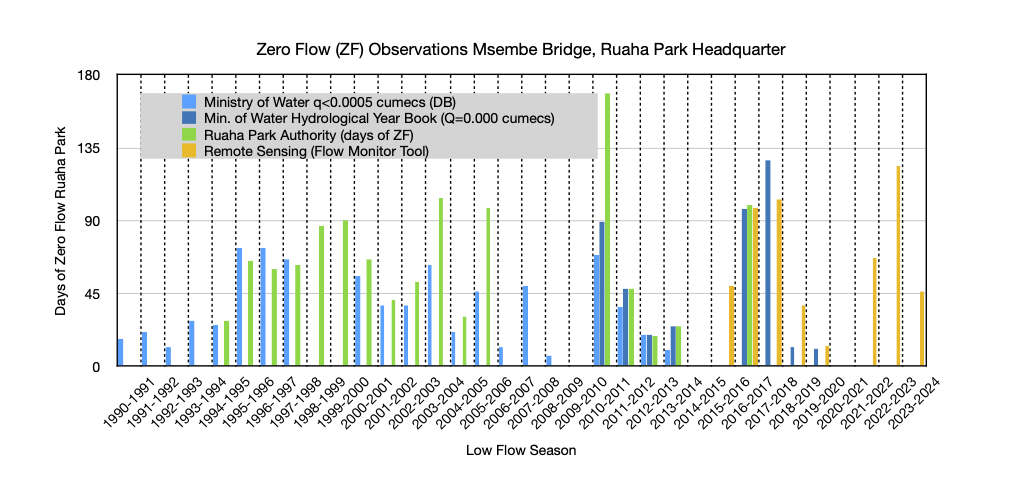History of Zero Flow
MENU
History of Zero Flow Days at Ruaha Park HQ (graph)

History of the Length of Zero Flow Series and Low Flow Periods
Table 2.: Days to Zero Flow at Park HQ
| Alert Levels | 2018 | 2019 | 2020 | 2021 | 2022 | 2023 | 2024 |
| Alert 1 | 131 | 170 | 119** | 120 | 70 | 82 | 95 |
| Alert 2 | 102 | 140 | 85** | 75 | 35 | 52 | 55 |
| Alert 3 | 69 | 37 | 47** | 17 | 22 | 19 | 52 |
| Dry Season Park* | June 29 to Dec 15 | June 3 to Dec 2 | Aug 12 Dec** | July 16 to Jan 21 (2022) | June 12 to Jan 23 (2023) | July 27 to Dec 2 | Aug 24 to Dec 3 |
(* Start and end of dry season, taken as period between one month before drying of Ruaha River at Mtera (not the Alert One announcement date unless accurate) up to the return of flow in the Ruaha at Park HQ – Msembe. Due to human activities in Usangu the length of the ‘dry season in Ruaha Park’ is not solely climatological.
(** In 2020 no zero flow was observed at the Park HQ but did occur downstream of Msembe Bridge including the section at Mtera. Zero Overflow between N’giriama and the Park HQ, reflecting the critical minimum to zero flow level in the Park is taken as reference minimal/zero flow dates for 2020 and related alert periods for interventions.
The Ruaha Flow Monitor accumulates a wealth of freely available georeferenced images.
By searching on key locations along the Ruaha and Mbarali Rivers and other flow flow features, categories and dates historical images can be found and copied.
While this database gradually developes, the annual flow monitor cycles are archived. And positive trends as a result of successful water management interventions will become detectable.
The low flow status during the critical period of the dry season of the Ruaha River for 2020 to today are now available. Critical periods are defined by ALERTS announced by this website. Table 2. presents the alert phases defined by increased urgency for intervention in non-essential abstractions from the Ruaha and Mbarali Rivers. As no rice irrigation should take place from June until the rainy season arrives which can be as late as January or February, continuous flow of the Ruaha can be achieved by monitoring non-essential abstractions. As only these two rivers flowing during the period of zero flow occurrence in the Great Ruaha River a limited area in terms of remote sensing is considered.
Alert one, predicted one month before the Ruaha River dries at Mtera which event occurs every year, probably since the 1950s. Alert Two, observation of the first day of zero flow (no flow) at a virtual drainage assessment section (VDAS). Alert Three is associated with critical low drainage flow from the Usangu Rice Plains. At Nyaluhangu as the Mbarali and Ruaha Rivers have joined less reliable flow data from the flow measuring station are used as reference. In 2021 the drying of a side branch on June 25, 2009 related with approximately 8cumecs has been adopted as last and most urgent call for controlling non-essential abstractions.
Interestingly the flow at the Ruaha Park HQ in both years returned as result of local rains in the Park rather than the onset of the seasonal rains in the upper reaches of the Ruaha. The image of January 11, 2024 shows the dry Ruaha River on that date from the south while the flow in the river downstream originates from the Jongomera coming from the North (Local Rains).
Apparently local rains in the Park may shorten the zero flow period which would otherwise have lasted one to three weeks longer due to the start of rice pre-irrigation at Usangu Plains before the onset of the seasonal storms in the upper reaches of the Ruaha and Mbarali Rivers, those years.